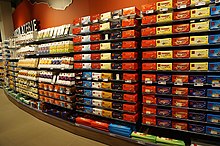food.wikisort.org - Dish
Swiss chocolate is chocolate produced in Switzerland. While cacao beans and other ingredients such as sugar cane originate from outside Switzerland, the actual production of the chocolate must take place in Switzerland. Switzerland's chocolates have earned an international reputation for high quality with many famous international chocolate brands.
 Artisan chocolate shop in Neuchâtel | |
| Place of origin | Switzerland |
|---|---|
| Main ingredients | Chocolate |
Switzerland is particularly renowned for its milk chocolate. In 1875, a Swiss confectioner, Daniel Peter, developed the first solid milk chocolate using condensed milk, which had been invented by Henri Nestlé, who was Peter's neighbour in Vevey.[1][2]
History


The 17th century saw the start of chocolate processed in Switzerland. In the 18th century chocolate was only produced in a few areas, such as the Ticino.
The early 19th century saw the first mechanized chocolate factories, all in western Switzerland. Among the pioneering industrials were François-Louis Cailler, Philippe Suchard and Charles-Amédée Kohler.
In the second half of the 19th century, Swiss chocolate started to spread abroad. Closely linked to this was the invention of milk chocolate by Daniel Peter in Vevey and the invention of conching by Rodolphe Lindt. Most large chocolate factories were founded in the 19th and early-20th centuries.
Timeline of chocolate factories foundations:
- 1819 - Cailler in Vevey (today Nestlé)
- 1826 - Favarger in Versoix, Canton of Geneva
- 1826 - Suchard in Serrières (today Kraft Foods)
- 1830 - Kohler in Lausanne (today Nestlé)
- 1836 - Sprüngli in Zurich, company split into Confiserie Sprüngli and Lindt & Sprüngli in 1892
- 1852 - Maestrani in Luzern (today in Flawil)
- 1856 - Klaus in Le Locle, Canton of Neuchâtel
- 1867 - Peter in Vevey (today Nestlé)
- 1879 - Lindt in Bern (today Lindt & Sprüngli)
- 1887 - Frey in Aarau (today Migros)
- 1899 - Tobler in Bern (today Kraft Foods)
- 1901 - Villars in Villars sur Glâne
- 1903 - Cima-Norma in Torre (closed in 1968)
- 1908 - Felchlin in Schwyz
- 1928 - Stella SA in Lugano (1987 Giubiasco)
- 1929 - Camille Bloch in Courtelary
- 1932 - Teuscher in a small town in the Swiss Alps
- 1932 - Bernrain in Kreuzlingen
- 1933 - Halba in Wallisellen (today Coop)
- 1934 - Kägi Söhne in Toggenburg
- 1957 - Alprose in Caslano
- 1962 - Läderach in Ennenda
Sales market

From the 19th century until the First World War and throughout the Second World War the Swiss chocolate industry was very export-oriented. After the Second World War Switzerland began to outsource production due to commercial restrictions.
Today most Swiss chocolate is consumed by the Swiss themselves (54% in 2000), and Switzerland has the highest per capita rate of chocolate consumption worldwide (11.6 kg (25.6 lbs.) per capita per annum).
In 2004, 148,270 tonnes of chocolate were produced in Switzerland. 53% of this was exported (20% to Germany, 11% to France and Great Britain and 13% to North America). The gross income of the Swiss chocolate industry in 2004 was 1.37 billion CHF (814 million from the local market, 551 million from exports).[3]
Industry structure
In 1901, Swiss chocolate producers created the Union libre des fabricants suisses de chocolat. In 1916, this was divided into the Chambre syndicale des fabricants suisses de chocolat and the Convention chocolatière suisse. The former "Chambre syndicale" (today the Chocosuisse) protects the interests of Swiss chocolate producers. The "Convention chocolatière" focused on the quality of the chocolate and sought a uniform price strategy. In 1994 the Convention was disbanded.[4]
Tourism

Several factories have also become tourist attractions as they include guided tours and chocolate museums. Some of the largest are the Lindt Home of Chocolate in Kilchberg,[5] the Maison Cailler in Broc and the Maestrani's Chocolarium in Flawil.[6]
See also
- Culinary Heritage of Switzerland
- Belgian chocolate
References
Some content of this article came from the equivalent German-language Wikipedia article (retrieved October 10, 2006), where the following references is cited:
- Alain J. Bourgard: CH comme Chocolat, 2003, ISBN 2-8321-0036-8
Notes
- Mintz, Sidney (17 April 2018). "The Oxford Companion to Sugar and Sweets". Oxford University Press. p. 524 – via Google Books.
- Moskin, Julia (13 February 2008). "Dark may be king, but milk chocolate makes a move". The New York Times. Archived from the original on 14 May 2016. Retrieved 1 January 2016.
- "Swiss Chocolate Fights Imports". Chocolate Trading Company. Retrieved 13 June 2021.
- "Chocology" (PDF). Chocosuisse. Retrieved 13 June 2021.
- "Lindt has opened the world's largest chocolate museum in Zurich, complete with the largest chocolate fountain". timeout.com. Retrieved 7 April 2021.
- "Le nouveau temple du chocolat". Le Matin. Retrieved 27 March 2022.
Avec ses 411 864 visiteurs l'année dernière, la Maison Cailler figure en tête des attractions touristiques suisses, en termes d'affluence. [...] Si le Chocolarium ne va donc pas forcément chambouler la hiérarchie des musées chocolatiers pour l'instant, il vient néanmoins renforcer l'offre culturelle de la Suisse en la matière. Une valeur sûre qui a toujours su attirer un grand nombre de touristes dans le pays.
[With its 411,864 visitors last year, the Maison Cailler is the top Swiss tourist attraction in terms of attendance. [...] If the Chocolarium is therefore not necessarily going to upset the hierarchy of chocolate museums for the moment, it nevertheless reinforces the cultural offer of Switzerland in this area. A safe bet that has always been able to attract a large number of tourists to the country.]
External links
- Swiss chocolate in the Culinary Heritage of Switzerland
- Chocosuisse: Union of Swiss Chocolate Manufacturers
- Information about Swiss Chocolat:www.swissworld.org
- Annual International Chocolatiers and Chocolate Fair
Другой контент может иметь иную лицензию. Перед использованием материалов сайта WikiSort.org внимательно изучите правила лицензирования конкретных элементов наполнения сайта.
WikiSort.org - проект по пересортировке и дополнению контента Википедии
